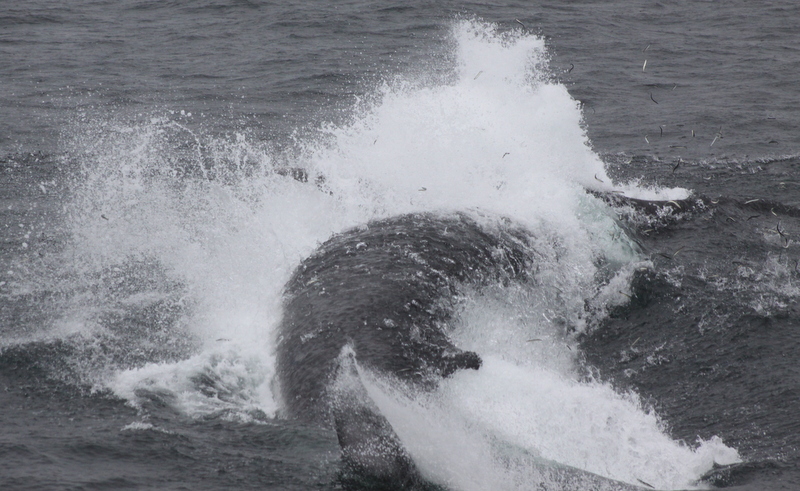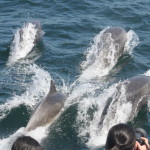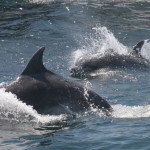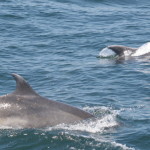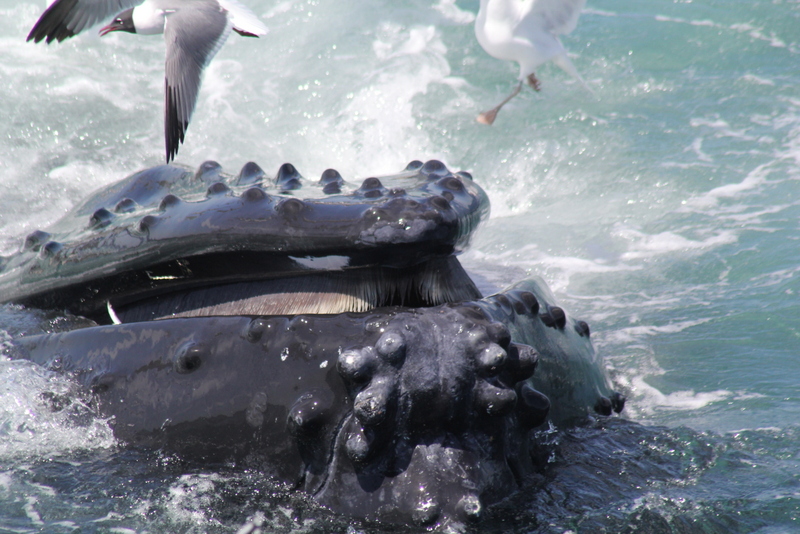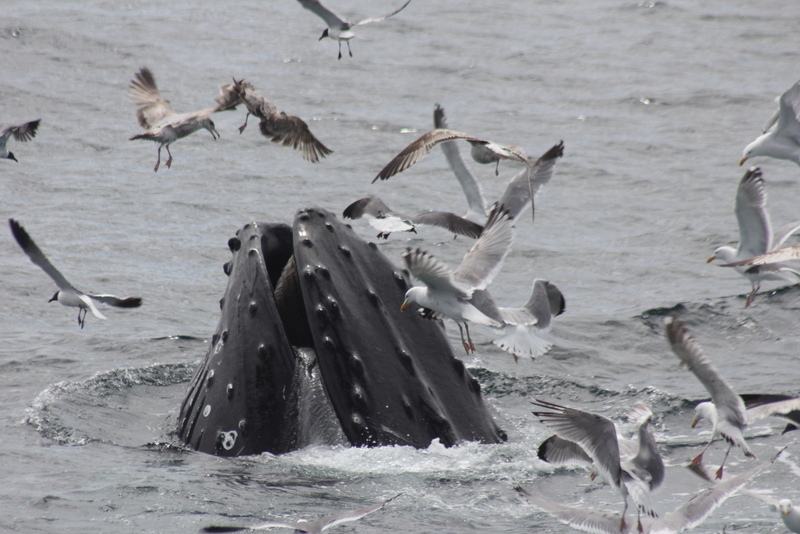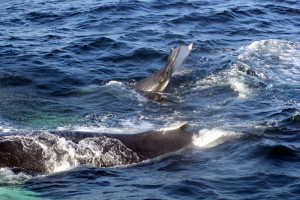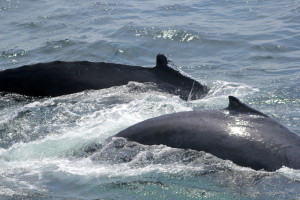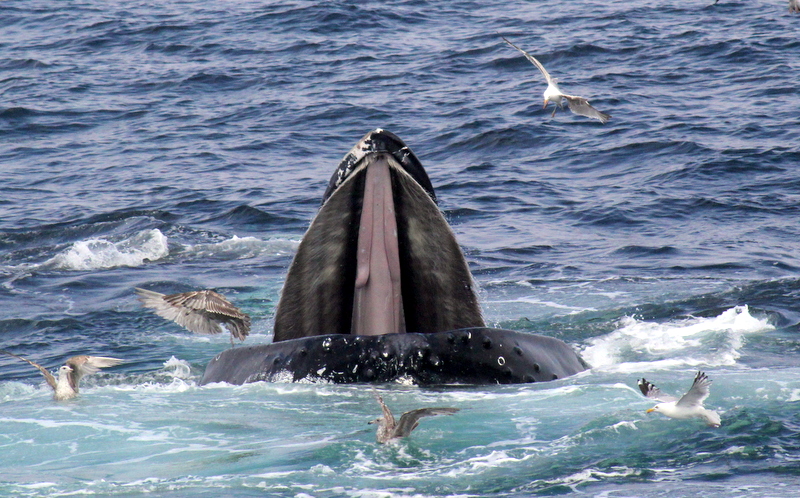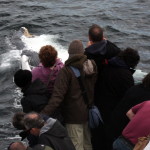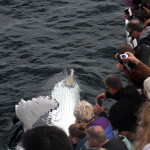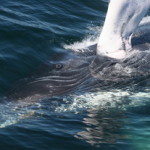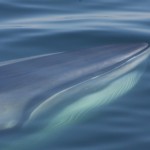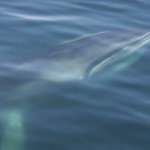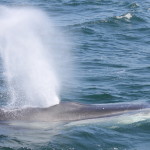Naturalists’ Notebook: July 04 to July 10
* If you were to look back at the Naturalists’ Notebook for this week last year, you would repeatedly find mention of a humpback whales named Nile. And pretty much only Nile. Oh, there were also minke and finback whales. And there would ocassionally be a second or even a third humpback whale listed as sighted in the lower Gulf of Maine. But the story of last July was that of Nile making her living along the southern and western edges of Stellwagen Bank. Sightings of Nile are conspicuously absent this month. This week, however, has seen the sightings of more that forty other humpback whales. For a listing of those individuals, refer to the daily sightings blog.
* And, the week started with a bang! This was appropriate as it began with Independence Day. Only one trip actually got to sea on July 04. The front of hurricane Arthur brought some long swells, some gusty winds, and lots of rain. (I feel the need to point out that, as much as it is necessary and beautiful in its own way, rain is a four-letter word. Especially in that amount.) But, as I have told many a whalewatcher, the weather that effects us usually doesn’t alter the behavior of the whales.
* A dozen and a half humpback whales were found, on just this one trip, outto the north of the triangle. Feeding. Blowing a variety of bubble systems and kicking at the surface to corral the schooling fish closer together. Big, slow lunges at the surface with their mouths wide open would follow the bubbles and kicking behaviors.
* Another thing you might remember from July 04, 2013 is the sighting of Bottlenose Dolphins.
* Hurricane Arthur kept the Dolphin Fleet safely in the harbor on July 05, 2014.
* “After two days of cancelled trips due to Hurricane Arthur, we went out.” “There was a day, last week, with dozens of humpbacks, but that had changed prior to the storm. So it was with great surprise that we found dozens of humpbacks, all kickfeeding across the horizon… Overwhelmingly wonderful!”–Mark Gilmore, about his adventures aboard the Dolphin X on July 06. “There were too many humpbacks to count.”–Kathy B. From the crews, “awesome”, “stupendous”, “lovely”, and “once in a lifetime”. And these are from people who see whales every day. And these are not what they said to the passengers, these are what they said to each other and to the crews of the other boats.
* What brought all of this on? Feeding! Nearly forty humpback whales making their living on small, schooling fish. Bubble clouds. Bubble nets. Bubble columns. Kick-feeding. Mouths open wide as they slowly ascended from the deep in the middle of the surface disturbance they had created.
* Imagine you are sitting on the bow of a boat. Just a dozen feet from you, you see a little burst of bubbles turning the water green as they rise to the surface. A few seconds later, a second rises just a few feet to the right of the first. Then a third. And a fourth. And so on, making a spiral of green bubble clouds that rise to the surface. In the interim, though, as those bubbles rise up, the huge, dark body of a humpback whales also rises to the surface, spouts, arches its back and lifts its flukes (nearly 15 feet wide) above the surface and slaps the water twice right where the bubble columns are rising. Huge clouds of green bubbles are the result.
* If you are a small fish at that moment, there is now confusion everywhere. When you first saw the bubbles deep down below you, you were startled. Confused, you did what only comes natural to you. Get as close to the other fish in your school as you can. Many times in your short life, this trick has saved your life so, as the bubbles rise up around you, you just move along with the rest of the school toward the surface. You are scared and you are confused, but there is strength in numbers. As you near the surface, though, you hear this noise and suddenly the leading fish of your school is pushing back against your forward (and upward) travel. They are trying desperately to move down, while you, driven by your fear of the bubbles beneath you, are trying desperately to move up. Everybody is suddenly really close together.
* And that’s when the open mouth of the whale slips past and around you and your schoolmates, nearly unseen until the push of the water around you gives your plight away. You are in the mouth of the beast. It will consume you if you don’t get out. But the upward motion is too much for you to swim against, regardess of how hard you try.
* Suddenly, there is light. And the water is disappearing around you, leaving you dry on the tongue of a humpback whale. You have but one chance. You need to jump. You need to jump as far as you can, past the curtain of baleen plates ringing the upper jaw of the beast and out of its mouth. Only then will you be back in the water and safer than you are now.
* Millions of sand eels, herring, and mackerel have this experience every day. Most, alas, do not survive.
* July 07 was largely about feeding whales, if you were looking from the deck of a boat. Fortunately I was. This is the kind of thing I was able to watch repeatedly throughout the day. The highlight of the day was, undoubtedly, when Etch-a-sketch (feeding much like just described) was then joined by her calf. The calf, about seven months of age, is not ready to feed on fish yet, but so beautifully mimicked its mother in the kicking over the bubble system that I thought it might actually lunge through the pile of fish itself.
* In addition to all the feeding, there were a few humpbacks that felt they had time to spend otherwise. So, there was also lobtailling and flippering and even breaching. As much as it was not a one event kind of day, it was also not a one species kind of a day. Minke whales and finback whales were also enjoyed, as were the atlantic white-sided dolphins.
* There was , again, on July 08, a great deal of feeding behavior from the humpback whales. But there were also numerous sighting of mother and calf pairs. One female sighted today with a calf was Salt. Sighted today with her 13th known calf, she is also a great-grandmother this year. (Her grand-daughter, Etch-a-sketch, is also a mother.) Her calf is the only of this year’s calves to already have a name, Epsom.
* Note the cleft palate of the above feeding humpback whale. It would be hard to say what caused it. Regardless of its origin, it is the palate of Salt. She is one of very few that can be identified accurately by looking at the inside of her mouth.
* Again, on July 09, most of the whalewatch trips found themselves surrounded by feeding humpback whales. Today, the smooth surface of the water made it easier to see just how intricate the nets of bubbles blown by them were. It also made it easier to keep track of the numerous calves that, with nothing better to do while Mom is feeding, became curious about the very large objects floating at the surface of their world. Several calves were seen rolling around beside the boats and even under the bowsprit on two ocassions.
* The day also featured incredible looks at finback whales (for those of you who have not been following along, finback whales are the second largest animals to EVER have lived on earth.)
*July 10, saw a lot of the same type of feeding activity from the adult humpback whales, one trip reporting over three dozen of them. And there were frolicking calves, as well.
Minke whales were also seen. The highlight of the day would have to have been the finback whales that were feeding at the surface, taking big, fast lunges through the schools of small fish and sending up waves of water as they passed.